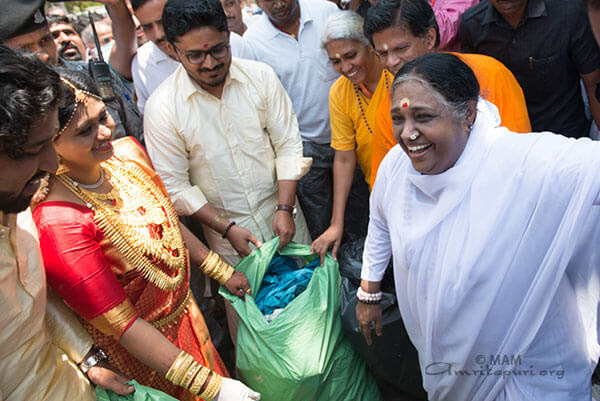 Editor’s Note: Amrita Yoga is more than just asanas; it’s a tool to experience the treasures of India’s ancient scriptures and yoga philosophy.
Editor’s Note: Amrita Yoga is more than just asanas; it’s a tool to experience the treasures of India’s ancient scriptures and yoga philosophy.
Sage Patanjali outlines the path of Ashtanga Yoga, the eight limbs of yoga. The first limb is yama (moral regulations). The second limb is niyama (inner observances), the third limb is asana (posture), and the remaining limbs go on to elaborate on pranayama (participation with life energy through breath), pratyahara (withdrawal of the senses), dharana (concentration), dhyana (meditation), samadhi (absorption with Supreme Consciousness).
 According to Patanjali, aparigraha (non-possessiveness), is one of the yamas, the ethical disciplines or moral regulations. Aparigraha (non-possessiveness) means not grasping or holding onto things. Practically applied in our daily lives, it can mean giving away things we don’t need. In this article, Teertha tells how her satsang put it into practice.
According to Patanjali, aparigraha (non-possessiveness), is one of the yamas, the ethical disciplines or moral regulations. Aparigraha (non-possessiveness) means not grasping or holding onto things. Practically applied in our daily lives, it can mean giving away things we don’t need. In this article, Teertha tells how her satsang put it into practice.
Fundraising Seva
Climate change is bringing more natural disasters. We watch the news and feel helpless. What can we do?
 When the tsunami hit south Asia in 2004, many members of our satsang (in Victoria, Canada) wanted to do something. Within a couple of weeks, we organized our first yard sale. Although we’ve done other things to raise money, yard sales have been one of our best fundraising activities. We held five more that year.
When the tsunami hit south Asia in 2004, many members of our satsang (in Victoria, Canada) wanted to do something. Within a couple of weeks, we organized our first yard sale. Although we’ve done other things to raise money, yard sales have been one of our best fundraising activities. We held five more that year.
Yard sales are an easy way for a satsang or yoga community to work together and raise some money. They also benefit many people. Some of us also learn valuable lessons through participating in the sales.
“It gave me a good opportunity to let go of some stuff. Knowing that everything is God’s and is only lent to us, if we’re not using it we should pass it on. We’re not only letting it go to someone else, we’re raising funds for Amma,” said Dhyani Jo, who donated several bags of items.
If you hold onto things that you’re not using, it’s like stealing because you’re depriving someone else of the chance to use it. Those people who keep more things than they need, without giving anything to others who are badly in need of them, are really thieves. – Amma

At Amma’s Pacific Northwest Retreat a few years ago, one of the welcoming dignitaries gave Amma some gifts out of a brown paper bag. Amma held each one to Her forehead to bless it, and passed them on to Her attendant. When all the presents were given, apparently not knowing what else to do, the woman also handed Amma the empty bag! Amma accepted the bag too with the same respect! Many of us laughed. But of course, what else would She do? She sees the whole universe as Her own Self. At one of our yard sales, a fellow driving by asked if we had anything for free. “I felt irritated,” said Grace, one satsang member. “But Dhanya was pleasant and friendly to him. She learned he was living in his van. He was interested in a Coleman stove and she gave it to him for $3.50, all the change he had in his pocket. I was reminded that some of the people in our own city need help, too.”
 We began to get a constant flow of things. After the first couple of yard sales, we thought we must have exhausted the satsang’s resources. But for every sale, there was always more, and lots of good stuff.
We began to get a constant flow of things. After the first couple of yard sales, we thought we must have exhausted the satsang’s resources. But for every sale, there was always more, and lots of good stuff.
Letting Go
“Letting go of stuff I didn’t use made me realize I needed to be more thoughtful about what I spent my money on,” one satsang member said. “And seeing the endless flow of other peoples’ stuff made me realize there is always more where that came from. When we get rid of excess stuff, it doesn’t decrease our happiness.” In fact, getting rid of things makes us feel better. During one 3-month stay at Amritapuri, Kalavati enjoyed the peace and freedom of living in a one-room flat with very few furnishings. After she returned to Canada, one night she had an experience that made her get rid of all her extra possessions.

Waking in the night and walking to the bathroom, she saw strands of attachment linking her to every item in the dark house. “It was awful,” she said. “It felt like I was caught in a web.” Initially she wanted to live very simply in one room and rent out the rest of her house, but with a home-based business, that was not possible. However, she did donate as many things as she could to our yard sale. A few years later, she became a renunciant and now lives in Amritapuri. “It seems fitting that we in the West who have so many possessions should get rid of them to help those who have lost everything. Not only do we get the opportunity to serve, but we learn the actual value of things. If we’re not using them, it’s time to pass them on. An uncluttered house is more peaceful. And it’s both a blessing and a pleasure to help others.”
Tips for Yard and Garage Sales:
- As you collect items to sell, look for the ones that could bring more money at a consignment store, or sell them online.
- Advertise the sale as a ‘multi-family’. People will be more likely to come because they’ll expect a larger assortment of goods.
- Try to have the sale near a main road, in an area where there’s lots of pedestrian traffic. Use large bright signs on poster board to lead people from nearby main roads.
- Bunches of balloons help people to see you, and make it look more friendly and attractive.
- Borrow tables from a church or organization to display the items on.
- Have a plugged-in extension cord so people can try out the electrical items.
- Play easy listening music. Pleasant sound gives people more privacy to talk to each other about potential purchases, and they also feel more relaxed about staying and looking.
- Have chairs for volunteers to sit on, plus one or two for shoppers who may need a rest, such as elderly folks.
- Let helpers who have lots of garage sale and second hand shopping experience decide the prices.
- It can save a lot of time not to put prices on less expensive items. When we asked prospective customers, “What do you think it’s worth?” often they named a higher price than we might have asked… So everyone was happy.
- Be willing to negotiate. Keep in mind you want to sell things. If items are priced too high, you’ll just have to store them or give them away when they don’t sell.
- If everything is jumbled together, it’s difficult for people to see what’s there. Display similar items together. Display especially interesting items out the front to draw people in.
- Set up a clothesline to hang clothes on, or borrow a portable wardrobe. Or set up a gazebo tent – it’s great to have some shade on a hot day, and also gives the yard an attractive, festive look that will draw people over to look.
- Be prepared with a cash float with lots of change and small bills.
- Consider offering a small assortment of baked goods and tea, coffee or juice for sale at reasonable prices (or to give to children).
- Have enough help to set up and get organized quickly. Otherwise ‘early birds’ will leave without seeing everything.
- Ask some helpers to come at the end of the day to pack up. Also ask people with larger vehicles to come and pick up unsold items.
- Before you organize the yard sale, figure out where you can take unsold items at the end of the day. Are members willing to store some of the ‘good stuff’ until the next sale? Things can get moldy in a basement or garage. Or is there a charity organization that will take them, the Salvation Army, a transition house, or organization for the homeless, or a ‘supersaver’?
- Have fun! Let us know how it goes. I’ll be heartbroken if that Porsche goes for a song.





